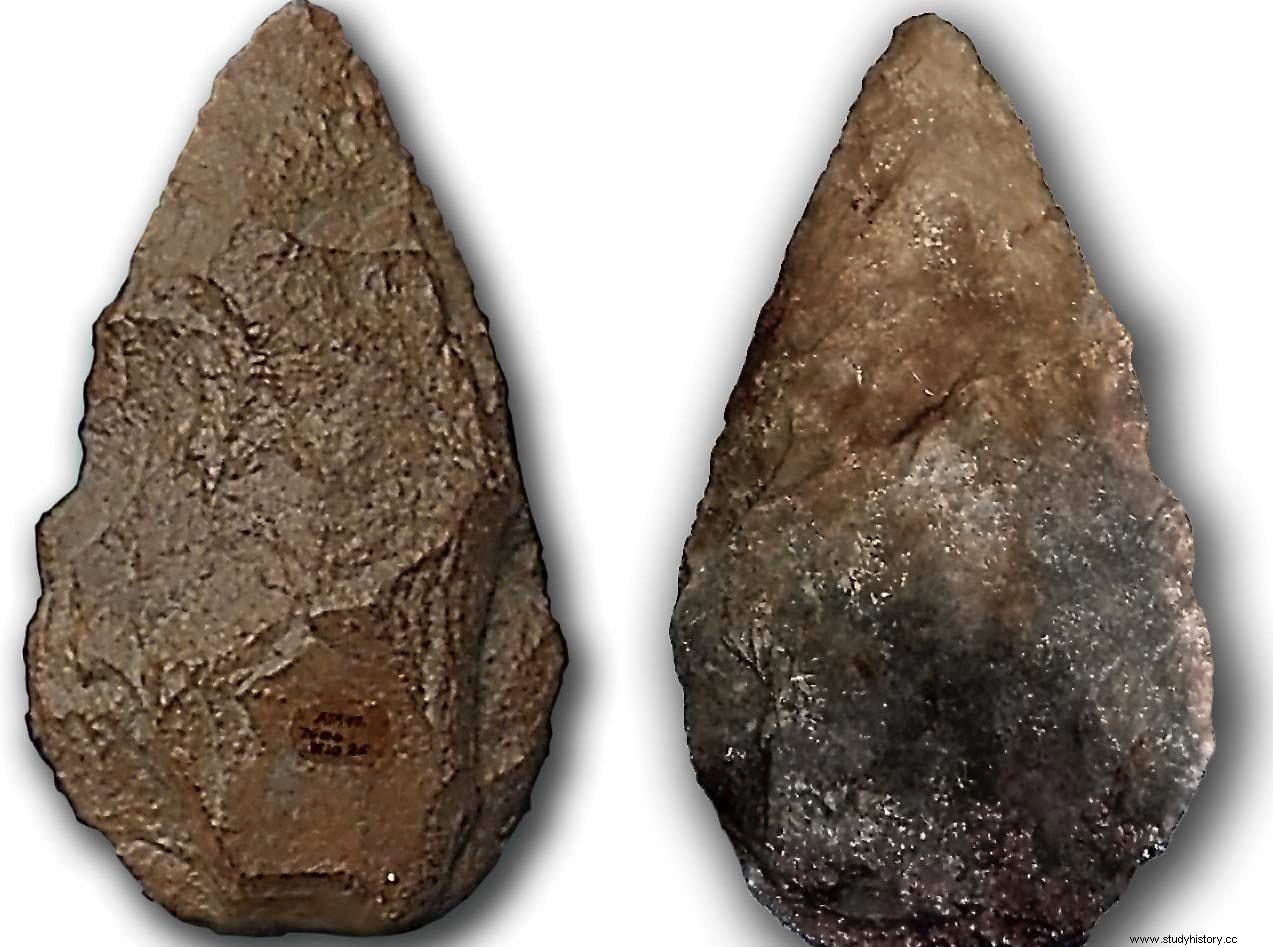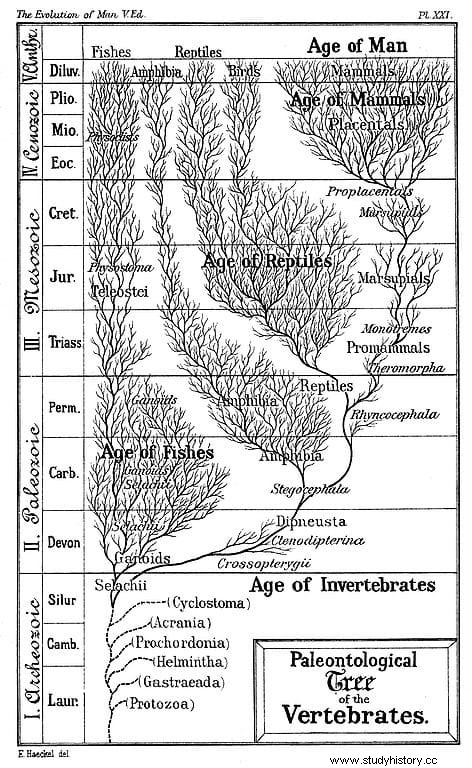Unless he was born in Denmark - and even then - it is unlikely that any reader knows who Christian Jürgensen Thomsen was. He is a Danish historian who, despite his lack of training -he was only fond of numismatics- and even today is almost unknown to most, created the basic classification of prehistory and Protohistory that was used until recently and that it is still maintained with the due updates:that of the Three Ages (Stone Age, Bronze Age and Iron Age).
Of course, it is a system that today has become obsolete for three reasons. In the first place, it is Eurocentric, since it only takes human development and the first civilizations of Europe as a reference. It does not take into account that the past and evolution in other continents do not conform to those schemes and, in fact, in America, for example, a different one is used, with another chronology (although its backbone is also tripartite:Preclassic, Classic and Postclassic); the same is true of Africa and Asia.

The second cause of obsolescence is that it is too simple. In the Stone Age, for example, several types of lithic techniques and cultures can be distinguished as different from each other as the Lower Paleolithic Acheulean, the Middle Mousterian or the series that occurred in the Upper Paleolithic (Aurignacian, Gravettian, Solutrean). and Magdalenian), not to mention the Azilian of the Epipalaeolithic and, later, the Neolithic. If we go to the Metal Age, things would get complicated with subdivisions (Ancient, Middle and Late Bronze).
Finally, explaining all of the above, it must be taken into account that Thomsen lived between the 18th and 19th centuries, when archeology began to take its first scientific steps and there was some confusion in interpreting the few prehistoric remains. On the other hand, this peculiar Scandinavian devised the Three Ages system with a specific purpose:to organize the funds of the exhibition presented in 1816 by the Danish Royal Commission for the Collection and Preservation of Antiquities.
Curiously, he was selected to curate it despite his youth -twenty-seven- and lack of training, since he was only the son of a wealthy merchant family from Copenhagen who had a special passion for numismatics. Perhaps that is why he did not want to complicate the matter and resorted to the classics. Because dividing history into ages was not new. The Greek poet Hesiod, who lived between 750 and 650 BC, simultaneously with Homer, established five (Golden, Silver, Bronze, Heroic and Iron) in his poem Works and days . Nor was it new to base it on the material that was most worked on in those ages, as we can see.

But surely Thomsen's most direct influence was Lucretius, a Roman poet-philosopher of the 1st century BC. that, in his work De rerum natura , he also structured History in three ages characterized by the work of metals (stone-wood, bronze and iron), although reversing Hesiod's interpretation; if the Hellenic rhapsode established a progressive moral degradation from gold to iron, concluding that he did not like being part of the fifth stage, the other only saw an inevitable evolution. Over time, there were other, more immediate precedents that influenced Thomsen.
Until the 16th century, thanks to the work of the physicist and physician Michele Mercati, no one considered that the traditionally called ceraunias or lightning stones were tools of past times (today we know that they are bifaces carved in flint during prehistory). Nicolas Mahudel, a French antiquarian and numismatist who lived between the 17th and 18th centuries, demonstrated that these prehistoric stones were worked by humans. In 1723, Antoine de Jussieu, a naturalist, botanist and physician from Lyon, published an article entitled De l’Origine et des usages de la Pierre de Foudre in which he confirmed the artificial character of the ceraunias.

Likewise, in a lecture given in 1734 before the Académie des Inscriptions et Belles-Lettres (a French scientific society dedicated to the study of the human sciences), Mahudel read an article of his entitled Les Monumens les plus anciens de l’industrie des hommes, et des Arts reconnus dans les Pierres de Foudres which added to the stone the use of bronze and iron in imitation of the first, which made it easier for him to establish a Stone Age-Bronze Age-Iron Age sequence.
Mahudel had been a Jesuit and ended up as a Trappist monk, with the curious circumstance that, at the same time, an ex-military man converted into a Benedictine named Bernard de Montfaucon, who was the creator of paleography and a forerunner of archaeology, also divided Human prehistory in three ages. In contrast, Vedel Simonsen was not a clergyman but he was Danish, so he was probably the most immediate influence on Thomsen.
Lawyer and doctor, the typical romanticism of the time pushed Simonsen towards the study of History, working in the archives and library of the University of Copenhagen and later moving on to work at the Commission for the Storage of Antiquities. Become a professional historian, in 1813 he published a work entitled First residence, oldest inhabitants and earliest destination or, in which he distinguished a Stone age, a Copper-Bronze age, and an Iron age.

Thomsen collected all this theoretical legacy and applied it to the aforementioned collection to divide its typologies into three, later deepening with reports sent by archaeologists. It was not easy because the origin of many pieces was unknown, but he was able to distinguish one from the other and notice the evolutionary differences that they presented in relation to the material they were made of:the stratigraphic analyzes showed that stone, bronze and iron did not coexist as materials of the tools and weapons of our ancestors, which allowed us to configure a chronology by progressively more recent ages.
The system was accepted by the academic world in general, which might seem surprising given the poor qualifications of the author, but remember that many other researchers had proposed it before, so everyone was familiar with it. However, Thomsen included his contributions that expanded and perfected it. For example, after examining the grave goods of numerous burial mounds, he eliminated silver and gold as their own ages because he observed that these precious metals always appeared associated with bronze or iron, not with their own stratigraphic profiles, as happened with other materials such as glass. . Also, the stone was associated with ceramics, amber and glass beads.

Furthermore, Thomsen had the ability to make his chronology fit that of the Bible , so that there would be no friction with the clerical world. His work on the Danish collection, which was unpaid, took him three years and when he finished it in 1819, the Museum of Northern Antiquities was opened, the germ of the future National Museum. In 1836, his prestige established, he published Ledetraad til Nordisk Oldkyndighed (Guide to Scandinavian Antiquity), a book in which he officially explained his chronology and which served as a training manual for the next generation of archaeologists; including those from other countries, since the work was translated into English in 1848.
However, the continuous increase in finds from the 19th century onwards notably broadened the horizon of archeology and soon made the Danish chronology obsolete, due to its inadequacy. The astronomer and mathematician Sir John Lubbock was the first to introduce tweaks in 1865, establishing in his work Prehistoric times a parallelism between techniques and customs, opening the door to cultural anthropology and distinguishing between a Paleolithic (age of the ancient stone) and a Neolithic (age of the modern or polished stone), so that it went from three ages to four , as Sir Charles Lyell had proposed in Principles of Geology .
Lubbock, impregnated with the colonialism and racism typical of the time in which he lived, that of the British Empire, conceived these prehistoric societies in an evolutionary way; After all, he was a good friend of Darwin and defended his ideas from the beginning against the traditional biblical chronology of the Ussher-Lightfoot calendar. But two years later, the German naturalist and philosopher Ernst Haeckel, the introducer of Darwinism in his country, broadened the spectrum by speaking of Archeolithic, Paleolithic, Mesolithic and Caenolithic. He followed the model suggested shortly before by Hodder Westropp.

In 1872 it was Sir John Evans, an archaeologist and geologist who had excavated together with Lubbock in Hallstatt, who published The Ancient Stone Implements rejecting the term Mesolithic in favor of two ages that would be Archeolithic or Paleolithic and Neolithic; there were numerous voices that pointed to the huge gap that would be left in the middle. They were, above all, the French Édouard Lartet, Gabriel de Mortillet and Édouard Piette, since national schools with divergent approaches began to differentiate themselves.
In 1915, the Swedish Knut Stjerna further complicated matters by showing that a period was not the same in one place as in another. In addition, he introduced two new concepts, Protoneolithic and Epipaleolithic, the latter as a substitute for the reviled Mesolithic. In reality, both covered the same period and were still the same thing, a transition, but the German Hugo Obermaiaer enthusiastically embraced them the following year, in his work Fossil Man .

However, by the end of the 19th century, a new type of classification formulated at the beginning of the century and based on geological criteria began to prevail:Paleozoic, Mesozoic and Cenozoic.
It was Haeckel who in his book History of Creation (1870) added complements such as Upper, Lower and Middle instead of Early, Late and Middle, to detail each period of his classification:Pliocene and Diluvial, which followed Lyell's 1833 (Eocene, Miocene and Pliocene, adding in 1839 the Pleistocene). Other authors were also making his contributions.
The Bronze Age also suffered from this dialectic. John Evans distinguished three stages in it (Early, Middle and Late), although he also spoke of a transition period from the Neolithic which he called the Chalcolithic or Copper Age. The discoveries of the Italian Gaetano Chierici represented another conceptual innovation:that of the Eneolithic, immediately adopted by the British as a synonym for their Copper Age .
That is where Prehistory ended and the Iron Age was entered, which is often somewhat confusingly defined as Protohistory due to the variety of chronologies required by geography, although it is a term little used.

The truth is that, currently, the periodization has branched out according to the region of the world (for example, in Africa it went from the Stone Age to the Iron Age without going through Bronze or Copper) and the chronology is different for each period, with different start and end dates (thus, in the East, the Iron Age would end with the Achaemenid Empire while in Asia it would end with the Mauryan Empire and in Europe with the rise of Rome... but in Scandinavia it would last until the Viking Age , etc).
